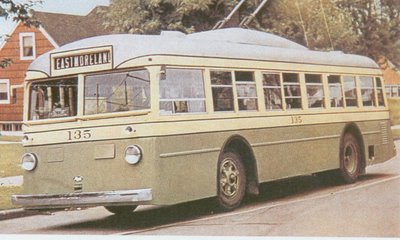
Portland once had an electric bus network that was state-of-the-art modern, clean, inexpensive and popular. Like a streetcar they drew power from electric catenary suspended from poles. Like conventional buses they rode on rubber tires. This allowed curbside loading which was not possible for streetcars whose tracks were laid in the center of the road.
Widely known as trackless trolleys or trolley buses, in Portland they were called trolley coaches.
They were never the predominate mode of public transportation in the city.
Prior to World War II they supplemented a decaying streetcar system. After the war they were gradually replaced by ever increasing orders of motor buses. If the war had not interrupted their progress, it is possible that they would still be running in Portland as they continue to do in Vancouver BC, Seattle and San Francisco.
They were quiet, economical and clean. They had zero greenhouse gas emissions.
In Portland they are largely forgotten.
The 1930s were hard times for public transportation in Portland.
The streetcar lines of the once mighty Portland Railway Light and Power Company were re-organized as a separate susidiary called Portland Traction to put financial distance between the streetcar system and its profitable electric utility company parents.
Ridership was down but fares were prohibited to rise by terms of the company's operating franchise. The vast majority of its equipment pre-dated World War I and its infrastructure was becoming ever more expensive to repair. At one point the company offered the city its entire track network to be used and maintained as a public throughfare (like roads or bridges) for the cost of one dollar (Portland Traction would have continued to provide service on the city's tracks).
The city demurred.
To make matters worse, just when the franchise which allowed the company to operate on city streets was due to expire, and an unexpected rival appeared on the scene. The Portland Motor Coach Company, a front for the United Cities Motor Transport , a subsidiary of bus manufactorer Yellow Coach (later a part of General Motors) offered to operate a motor bus system in Portland in the place of the electric utility owned streetcar system.
Portland Traction's response to the threat was to explore the use of trolley buses which were gaining popularity in other cities.
A plan was submitted to the city council for "coordinated service" which utilized new trolley coaches, modern streetcars, and motor buses for the outer routes.
A trolley coach test loop was then set up on Broadway, Jefferson, 13th and Yamhill using coaches borrowed from Toledo Ohio's Community Traction Company.
Responses listed in a "Coodinated Service" pamphlet "from 10,000 opinions" included:
"More comfortable..safer..good looking." -A.N.
"Amazing flexibility in traffic." -M.F.N.
"So much better in every way." -E.M.
"Less noise, no fumes, more speed." -M.L.M.
"Uses electricity, a home product." -E.W.N.
It is possible that the quotes were creations of Portland Traction's publicity department but none the less, public acceptance was enthusiatic and fast in coming.
The Yellow Coach offer of a motor coach bus system was withdrawn.
On January 31 1936, in the midst of the public excitement over the new trolley coaches, a new twenty year franchise was granted to Portland Traction. A modernization plan was adopted which called for the current system of 27 streetcar lines and 7 motor coach lines to be upgraded into system with 7 trolley coach lines (45 miles), 14 streetcar lines (63 miles) and 9 motor coach lines (47 miles).
A new green and yellow-cream paint scheme, selected by the school children of Portland, was adopted by the company for its trolley coaches, streetcars and buses.

One of the borrowed Toledo trolley coaches loading on Broadway and Yamhill on the test loop. The Hotel Portland (now the location of Pioneer Courthouse Square) is in the background.
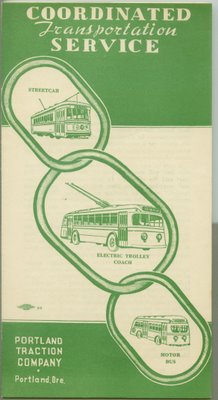
"Coodinated Transportation Service" was touted in this brochure given out at the test loop of the trolley coach. The streetcars featured were the 15 modern "Broadway" cars delivered in 1932.
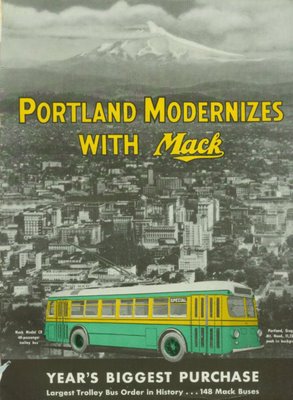
"Portland Modernizes with Mack" is proclaimed by an advertisement for the Mack CR 40-passenger trolley bus.
The Eastmoreland line was the first trolley coach route to be inaugurated on August 29th 1936, followed by the Hawthorne (1936), Foster (1936), Sandy Blvd (1936), 3rd Avenue (1937), St Johns (1937), Williams (1937), Interstate Avenue (1940), and Sellwood (1940).
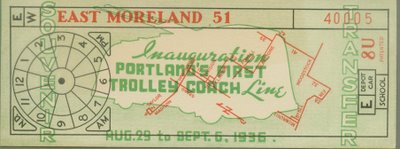
A souvenir transfer celebrating the inauguration of Portland's fist trolley coach route, the Eastmoreland, August 29th through September 6th 1936. On the back it reads "Keep this transfer as a souvenir of a modernization program giving Portland one of the finest mass transportation systems in the world. You will value its possession in years to come."
 Portland Traction #318 in the maroon and cream paint scheme introduced in 1939.
Portland Traction #318 in the maroon and cream paint scheme introduced in 1939.They were popular.
In a poll published by the Oregonian on April 9th 1940 on transit preferences, 80% of Portlanders favored the trolley coaches, 9% streetcars 2% gas buses, 1% "the present combination" while 8% "Don't Know."
The streetcars supporters were noted as being mostly over 50 years old. A middle aged widow noted that she liked "the old conductors." Several people mentioned they disliked the odor of the gasoline busses. Of the few people who did like gasoline busses, it was noted that all of them owned their own cars.
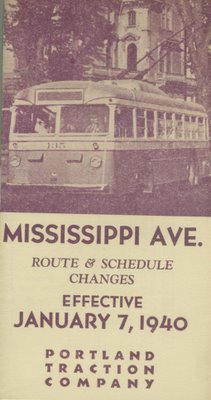
Portland Traction featured trolley coaches on all of there 1940 schedules including this one for the Missippi Avenue, a motor coach line in 1940. It would not be converted to trolley coach opeation until 1949.
Word War Two stalled the expansion of the trolley coach network.
The war placed a tremendous strain on the public transportation system.
In 1945 alone, Portland Traction hauled 163 million passengers, placing Portland in third place among American cities for that year. At the end of the war it was considered parmount to replace the streetcar system which was viewed by general public as decrepit.
Trolley coaches were not avaible for immediate post war production which left gasoline or diesel buses as the only option.
Support for the trolley coaches was so strong however, that in a poll done by the Oregonian of transit riders, ten to one favored trolley coaches, even if it meant waiting an additional three years for new equipment.
Commissioner Kenneth L. Cooper took a stand in favor of trolley coaches in a response to a protest by Lawrence and Grace Meissner against the company purchasing "new stink buses."
In 1946, the Portland Traction Company was sold to San Fransico based holding company named Portland Transit, which would operate Portland Traction (and its successor Rose City Transit) until the formation of Tri-Met in 1969.
"We will keep our present trackless trolleys: we like them and the people like them: but we will not have the finances at this time to put in the overhead systems for additional ones"
-Gordon Steele, President of the Portland Traction Company in the Oregonian, March 28 1946.
..."The Company believes that modern buses will be as popular as trackless trolleys. We doubt it".. The Oregonian May 8th 1946.
City Commissioner (later Mayor) Dorothy McCollough Lee released a report on July 13, 1946 which recommended trolley coach replacement for the Mt. Tabor, 23rd Avenue, Montavilla, Broadway, Willamette Heights, Alberta, Council Crest and Bridge Transfer streetcar lines.
In each case, over the next four years as the last streetcars were discontinued, buses were used as replacements.
An article about a new order of buses that appeared in the August 22 1946 Oregonian promised that gasoline odors would be eliminated by an "automatic de-gassing device." (!)
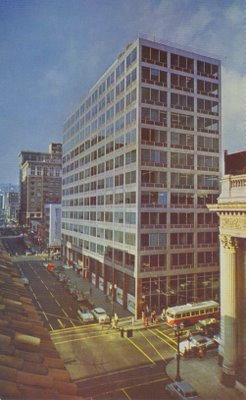
Portland Mid-Century Modern: The Equitable Building (today the Commonwealth Building) designed by Pietro Belluschi, and a trolley coach.
The postwar expansion of the trolley coach network finally resumed in 1949 with the addition of the Mississippi Line and an extension of Williams Avenue line in North Portland.
At the systems height circa 1949-1952 there were ten electric coach lines: St Johns, Interstate, Mississippi, Williams, Sandy Blvd, Hawthorne, Foster, Eastmoreland, Sellwood and 3rd Avenue.
Nine years after the last route was added, the entire network was gone.
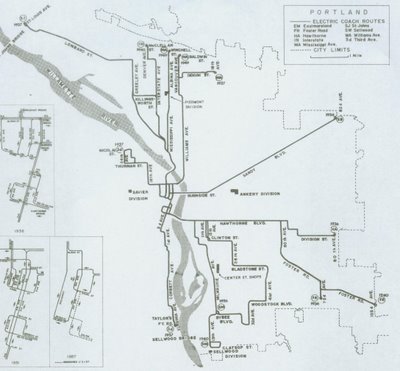
(click on map to expand..)
Portland's Trolley Coach system at its height circa 1950. From Motor Coach Age, September 1971.
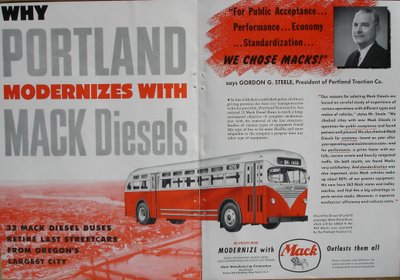
Portland was still "Modernizing with Mack," in this February 1950 advertisement, however with diesel buses which were credited with the removal of the final streetcar lines.
At transit ridership declined in the 1950s, Portland Traction moved away from electric powered transit, citing cost and technological improvements of the new diesel buses. According to figures provided by the company in 1951, it cost 43 cents a mile to operate a trolley coach, opposed to 38 cents a mile with a gas bus and 34 cents a mile with the new diesels. Maintenance of the overhead wire system was factored into the calculation.
If the war had not interrupted the expansion of the trolley coach lines, or, if Dorothy McCollough Lee's 1946 recommendations been followed, it would have been impractical to consider replacing the trolley coach network. As it was, the replacement of the final streetcar lines with motor coaches placed the tipping point clearly in the buses favor.
By November 21 1950 weekend service on all routes was covered by motor coaches. The Williams Avenue line was converted wholley to bus operation on February 17th 1952 and the 3rd Avenue line on August 10th 1953. Plummiting transit use allowed the conversions to take place with no additional equipment purchases.
In July 1953 Portland State student Donald K. Simpson lead an effort to return trolley coach operation on Saturdays, noting that the city ordinance that allowed bus subtitution on Saturdays had expired. In an emergency session, the city council voted to extend permission to Portland Traction to continue bus substitution.
"Electric trolley coaches are out of the picture because they cost four cents a mile more to operate and are almost 20 years behind in some phases of design."
"...As long as there are automobiles there will be fumes."
-Gordon Steele, President of the Portland Traction Company to the Lions Club,
November 27th 1953.
In 1956 the franchise that allowed the Portland Traction Company to provide the cities public transportation expired. A new company called Rose City Transit was created (though still owned, like Portland Traction, by San Francisco based Portland Transit) and granted a twenty-five year franchise.
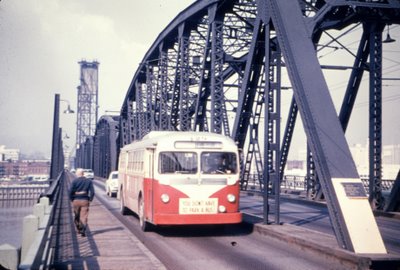
In 1956, a project which added approach ramps to the Hawthorne Bridge removed the trolley coaches from the Sellwood, Eastmoreland, Hawthorne and Foster lines in Southeast Portland. It also severed the Oregon City and Bellrose passenger inturban rail service to downtown Portland, easing the way for their (illegal) shutdown in 1958. The sign on the trolley coach reads: "you don't have to park a bus."
Rose City Transit announced the cessation of electric coach operation on January 29, 1958.
It soon became aparent however that there was not enough buses to cover the routes. Trolley coaches returned to the St. Johns, Interstate and Mississippi lines on February 25, 1958. On October 23, 1958 the company was finally able to retire last trolley coaches and replaced them with surplus diesel and gas busses. The wires came down shortly after.
"A few weeks ago the Rose City Transit Company, without any warning to the City Council, which in theory has regulatory powers over it as a public utility operating under public permit, took the trolley coaches out of service and began dismantling the trolley wires. Since it is evident the company does not intend to replace them and the Council plans to offer no more than feeble protests, Portlanders have probably seen the last of the fast, clean, oderless trolley buses that served them so well for twenty years." -Albert McCready, Associate Editor, the Oregonian, November 9th 1958.
Many of the coaches were scrapped, although one was stored for many years at Rose City Transit's (later Tri-Met's) Center Street Garage. One is rumored to be in Northern California.
Forty-five coaches were purchased by automobile dealer Joe Fisher, to be converted into portable cottages. The first was diplayed at the Fisher's lot and Burnside, priced "well under $3,000." Ruth Fisher of Jim Fisher Volvo remembers that Joe Fisher had lots of energy for the project, but that he had bought "a ton of them." Around half were sold as cottages "so it was a half good idea." The others were probably cut up after being stored for a long time in a lot near Tualitan. It is not known if any of the "trolley homes" still exist.
Afterword: In the mid-1970s, at the height of the energy crisis, there was an attempt at a revival. The Citizens for Immediate Adoption of Trolleybuses, headed by Ray Polani, a savings and loan executive, recommended that Tri-Met convert its close-in routes to trolley bus operation, using refurbished coaches from Chicago. There was even the possibility that funding from the U.S. Urban Mass Transit Administration for 100 new diesel buses would be delayed if a suit was brought by the CIAT. Nothing came of of the groups efforts. The trolley coach was largely forgotten as a transit option in Portland.
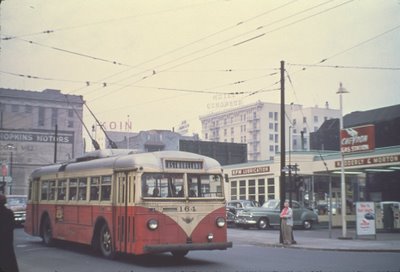
How would Portland's transit system look today if the trolley coaches survived? Public ownership would still have been inevitable. A rail component for longer distance high density transportation would also be very likely, as evidenced cities such as San Francisco (Muni lightrail), Vacouver BC (Skytrain) and most recently Seattle (lightrail), which kept their trolley buses.
If the trolley coach routes had been expanded, perhaps during the 1970's energy crisis, thoroughfares such as 23rd, 39th, Broadway, Burnside, Barbur and Division could have acquired electric buses.
Assuming the bus mall would have still have been built, it would be a much quieter, cleaner place.
The outer system would likely be diesel powered, due to the expense of installing and maintaining electric catenary. But if something along the lines of the dual mode trolley-diesel buses (used until recently on lines through Seattle's transit tunnel) or recent "Hybrid" diesel-electric bus technology were adapted for the outer routes, Portland would have been very close to having an all electric, very low emission emitting transit system.
Today It would be very popular.

San Francisco's Muni operates a fleet of trolley buses. On Market Street they share the road with Muni's historic F Line streetcar fleet (here a streamlined PCC car from the 1940s) and private automobiles. Beneath Market Street, Muni runs a light rail subway, and beneath that, BART (Bay Area Rapid Transit) a high capacity regional commuter rail system. Unlike Portland's future Transit Mall upgrade, busses on Market Street load from the curve while rail loads from pedestrian islands in the middle of the busy street. San Francisco CA, Market and Powell, March 16, 2004.
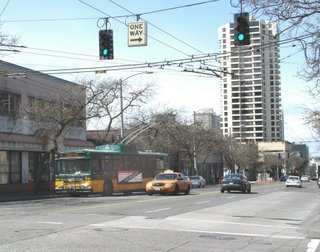
The Seattle Region's King County Metro has a large trolley bus system in the city's core. Seattle Washington, April 14, 2005.

TriMet currently operates two diesel-electric "Hybrid" buses. Small diesel engines power an electric generator that charges a battery pack on the roof, which turns the wheels of the bus. They are regarded as an experiment on TriMet, but Seattle's King County Metro Transit has purchased 210 similar vehicles. While delivering significantly lower emissions than a standard bus, the Hybrids cost more and have not been able to deliver hoped for fuel savings.

There are still traces of the trolley coach network in Portland, including a group of fourteen poles along Larrabee between Broadway and Interstate Avenue north of Memorial Coliseum. Painted green or black, some are used as light poles.

North Larrabee and Interstate, October 1, 2006. The green light post, left of center, once supported trollley coach catenary. This intersection is no stranger to electric powered transit. The Willamette Bridge Railway built Portland's first electric streetcar through there, at the boundary between the cities of East Portland and Albina, in 1889. The streetcar line was discontinued 1938. The St Johns trolley coach line was installed in 1937 (the Interstate and Mississippi Ave trolley coach lines would later share the routing). The trolley coaches were removed in 1958. Interstate Max opened in 2004.
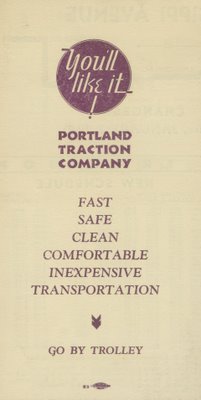
Thanks to:
Alan Eisenberg, who preaches the Gospel of the Trolley Coach.
Ken Lantz, Art Greisser, Roy Bonn, Mike Parker and Dick Thompson; the usual suspects when a mystery about Portland transportation history is discovered.
Ruth Fisher of Jim Fisher Volvo, who remembered the Trolley Homes.
11 comments:
This is some amazing history I didn't know about. The pictures are great too. It really puts the city's current transportation planning in context.
Hi,
My wife and I found your blog after finding a used trolley ticket for Portland in a book from Reed College. I have scanned it into my computer to send to you if you are interested in posting on your site.
You can email me at vcina @ verizon dot net.
Victor
When I was growing up in the 1950s-60s, I delivered a free newspaper called the Walnut Park News.
My route included a couple of trailer parks around N.E. Killingsworth and Cully Blvd. I'm certain that I remember a couple of the "trolley" homes hidden away in the recesses of the Cedar Shade trailer park.
Did you see the study in today's Oregonian (November 16, 2006) that claims that most of Portland's air polution is from diesel smoke?
Construction equipment belches more diesel exhaust into metro-area air than all tractor-trailers, buses and other diesel vehicles combined -- nearly 500 tons of soot a year, according to DEQ. An Oregon environmental advocacy group calls diesel exhaust the state's No. 1 air-quality problem. Here is a quote from the "O":
"Off-road sources -- tugboats and locomotives as well as backhoes and bulldozers -- contribute two-thirds of the soot in the air over downtown Portland." Come on, I've been behind a Tri-Met bus when they start off at a green light, and even though they direct the smoke to the top of the bus via the tail pipe, you can see a lot of soot coming out of those monsters. I was in Seattle last week and the "trackless trollies" that they are still running up there are super clean and quiet. I wish we had them.
I did write an endorsed Trolleybus systems bring back to Portland, Why do your organization can start up a petition drive, if anyone will do. I could see that Trolleybus comes back from dismantled in the history. I sent TRIMET, so I do not know what happened with TRIMET about trolleybus or articulated bus.
the articulated buses that ran out to beaverton / hillsboro were effectively obsoleted by the opening of westside MAX. the east side airport route that used articulated buses was also obsoleted by MAX.
the articulated buses themselves were expensive to maintain, and their parts were not interchangable with the rest of tri-met's bus fleet, so they were retired.
An article/ad by GE on the SF Muni history site related that the cost of running a trolley coach ($.36/ mile) was the least of any equip- ment run by Muni in 1949. The cost of overhead cantenary for trollies would be minimal when compared to the infastructure expense for more light rail or streetcars. Come on folks, it's time we told Trimet to stop adding to the toy train set.
My grandfather worked in Portland furing WWII. I have lots of 1943 Portland Traction Company bus or trolley passes, but have no idea what they might be worth. Any ideas of who might want them? Or are they a dime a dozen?
Fascinating info.
Really nice interesting history. Being a native Portlander born in 1959, I of course experienced non of the old trolleybus lines or streetcars. But being a student of rail and putting that out there, I find myself studying the remaining steel poles out there and occasional streets with poles on both sides and know they once had trolleys of one kind or another.
More amazing info from you, thanks for sharing. I rode the streetcars and electric busses in my school days, preferred rail but anything electric was great.
Are trackless trolleys or trolley buses can still be seen today? I think it will be cool if car manufacturing companies will restore an electric bus just like those.
Vince Fury
Post a Comment